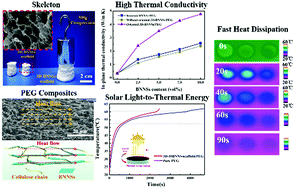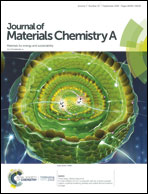Phase change material with anisotropically high thermal conductivity and excellent shape stability due to its robust cellulose/BNNSs skeleton†
Abstract
Phase change materials (PCMs), as promising energy saving and heat-dissipation materials, have the advantage of a high latent heat in the phase transition process, and thus have huge potential applications in electronic devices, powerful batteries and modern buildings. The aspirational target is to achieve excellent thermal conductivity (TC) and extraordinary shape stability in PCMs, while simultaneously maintaining their high latent heat. In this study, an anisotropic and robust three-dimensional interconnected cellulose/boron nitride nanosheet (BNNS) skeleton was designed within polyethylene glycol (PEG) composites via the self-assembly of concentrated cellulose/BNNS aqueous mixtures followed by vacuum impregnation and cold compressing. By virtue of this typical structure, the PEG composites could take full advantage of the high in-plane TC of the BNNSs due to their efficient orientation during the cold compressing process and immensely diminish the phonon scattering among the BNNS pathways due to the overlapping BNNS contact. In addition, a robust cellulose/BNNSs scaffold with impressive compressive strength (3.03 MPa) similar to reinforced concrete was obtained, which benefitted from the cooperative reinforcement of the cellulose nanofibers and high-strength BNNSs and could also avoid any shape change when vacuum-impregnated with PEG. As a result, the in-plane TC of the PEG composites reached as high as 4.764 W m−1 K−1 at only 10 vol% loading, which is almost 1400% of that of pure PEG. Furthermore, the PEG composites could also maintain their original shape at a high temperature (101 °C), even when loaded with a weight of 500 g, which is almost 500 times heavier than their own weight. Besides, the PEG composites with a relatively small loading of BNNSs could also maintain a high-level of latent heat (136.8 J g−1). All these excellent comprehensive properties guarantee them a bright future in applications such as energy conversion and storage systems and electrical insulating materials for thermal management.



 Please wait while we load your content...
Please wait while we load your content...